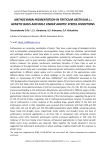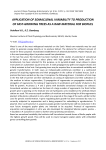Статьи журнала - Журнал стресс-физиологии и биохимии
Все статьи: 984
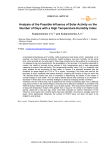
Статья научная
At elevated temperatures and humidity, cattle experience heat stress which, depending on its intensity, can lead to reduced productivity, health problems and even mortality. At the same time, some animals are currently kept in free-range conditions and this practice is increasing as it is believed to be more beneficial for the socialisation of the animals. It is therefore essential to monitor the health of animals during periods of high temperatures and to take appropriate measures to ensure their well-being. The temperature-humidity index (THI) is a threshold heat index suitable for the physiology of dairy cattle. In Russia, it is generally accepted that the threshold for stress begins at a THI of 75 or higher. Accordingly, this level was used as the boundary at which moderate heat stress develops. Analysing the number of days on which the THI reaches stress levels over time is important in determining the extent of the impact of climate change on cow health. This can help to identify factors that contribute to an increase or decrease in these days and to develop strategies to adapt to changing climate conditions. Therefore, the aim of this study was to determine the number of stressful days over a relatively long period of time in the Central Region of Russia and to attempt to establish a correlation with external factors influencing the climate, such as solar activity. This study shows that the number of days with temperature indices (THI) greater than or equal to 75 is likely to be related to solar activity, albeit with a one-year lag, which most likely indicates an indirect mechanism of this influence. At the same time, another factor has been identified, occurring on average every five years, which significantly influences the number of THI≥75 days, but does not seem to be related to solar activity.
Бесплатно
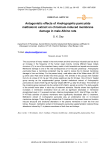
Статья научная
The occurrence of heavy metals in the environment and their enormous industrial use has led to an increase in the frequency of the human organ toxicity. Among different heavy metals chromium (Cr) is one of the important heavy metal in both terrestrial and aquatic environments. Membrane damage is one of the vital consequences of Cr-induced cytotoxicity. Andrographis paniculata Nees, a membrane protectant may be used to reduce the Cr-induced membrane damage in liver and kidney. For the present study, male albino rats of the Wistar strain (80-100 g) were used. Rats were divided into three groups. The animals of two groups were injected K2Cr2O7 at a dose of 0.8 mg per 100 g body weight per day for 28 days. One of the Cr treated group serving as the supplemented groups injected methalonic extract of Andrographis paniculata at a dose of 500 mg per Kg body weight (ME-AP500) daily for 28 days. The animals of the remaining group received only the vehicle (0.9% NaCl), served as control. The body weights of the animals were taken in each day of treatment schedule. Results shows that significant increases in membrane cholesterol level as well as significant decreases in membrane phospholipid level in Cr exposed animals. Alkaline phosphatase (ALP), total ATPase, and Na+-K+-ATPase activities of plasma membrane were significantly decreased after Cr treatment. Methalonic extract of Andrographis paniculata play an ameliorative role on Cr-induced membrane damage. These findings indicate that Cr treatment at the present dose and duration induces structural and functional alterations in the plasma membrane in both the liver and kidney. However, methalonic extract of Andrographis paniculata supplementation restored those alterations induced by Cr in plasma membrane of both liver and kidneys.
Бесплатно
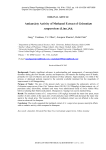
Antianxiety activity of methanol extract of Gelsemium sempervirens (Linn.)Ait
Статья научная
Background: Despite significant advances in understanding and management of neuropsychiatric disorders during past few decades, anxiety and depression, still remains the leading cause of deaths, primarily for want of effective and safe treatment of these ailments. Approximately, two third of the anxious or depressed patients respond to the currently available treatment but the magnitude of improvement is still disappointing Purpose of Study: The aim of the present study was to investigate the antianxiety activity of Gelsemium sempervirens (Linn.) Ait. Various doses (50,100, 150, 200mg/kg) of plant extracts viz., of petroleum ether, chloroform, methanol and water were administered orally to Swiss Albino Mice before evaluating their behavioural pattern. Diazepam (2.5 mg/kg) was used as standard drug. Result: The methanol extract of G. sempervirens (150 mg/kg) increased the mean time spent, mean number of arms entries in the open arms of elevated plus maze (EPM) and decreased the mean time spent in the closed arms. The locomotor activity of methanol extract was not affected to the same extent as observed for diazepam. Conclusion: The results suggested that methanol extract of G. sempervirens possess anxiolytic effects with no sedative activity when compared to diazepam.
Бесплатно
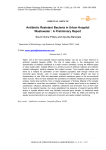
Antibiotic resistant bacteria in urban hospital wastewater : a preliminary report
Статья научная
Water, one of the most available natural bacterial habitat, can act as a major reservoir of antibiotic resistant bacteria (ARB). The role of waste water in the development and dissemination of antibiotic resistance is a major concern nowadays. Among the different types of urban waste water, hospital effluent is a primary source of antibiotic residues and antibiotic resistant pathogenic bacteria released from patient excreta. Thus hospital waste water can serve as a hotspot for generation of new resistant population both through vertical and horizontal gene transfer. Lack of proper management of hospital effluent can lead to dissemination of new ARB and associated antibiotic resistance genes to the environmental water sources. Here we have assessed the prevalence of antibiotic resistance among bacterial isolates, mainly fecal coliforms, from a hospital wastewater of Kolkata. Majority of the isolates were resistant to more than one antibiotic. Of them five isolates were found to be resistant to ciprofloxacin, ofloxacin, tetracycline, cefepime, cefotaxime and amoxicillin. Four of them were found to be plasmid bearing. Our study established the presence of plasmid bearing MDR strains in hospital effluent which may facilitate horizontal gene transfer. As traditional waste water treatment plants are not designed for the removal of ARB. So ARBs are entering the aquatic environment which is a major point of concern and needs constant monitoring.
Бесплатно
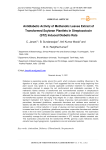
Статья научная
Diabetes is expanding quickly around the world, which produces unsettling influences in the digestion of sugar, protein, and lipid. Proof suggested that the normal drugs beginning from plant source may speak to a socially applicable correlative treatment for diabetes. This examination planned to assess the cell reinforcement and antidiabetic exercises of the methanolic leaves extracts of transformed and non-transformed soybean in streptozotocin induced diabetic rats. The enlistment of diabetes with a single dose of streptozotocin and afterward the rats are treated with single dose of methanolic leaves extracts of transformed and non-transformed soybean (50 mg/kg body weight) for 21 days. Glibenclamide is utilized as a standard medication (0.5 mg/kg b.w.). The degree of glucose, lipid peroxidation, glutathione peroxidase, decreased glutathione, superoxide dismutase and catalase were resolved in diabetic rats after the treatment. The administration of methanolic leaves extracts of transformed soybean saw a critical reduction in levels of glucose and lipid peroxidation. The significant increased was found in glutathione, glutathione peroxidase, superoxide dismutase and catalase levels in the liver when contrasted and diabetic control rats after medicines. The examination demonstrated that the methanolic leaves concentrates of transformed soybean rewarded rats successfully manage the cell reinforcement exercises in STZ induced diabetic rewarded rats. This examination presumed that the transformed (PPARγ gamma) crude methanolic leaves extracts have huge hypoglycemic, hypolipidemic and cell antioxidant potential.
Бесплатно
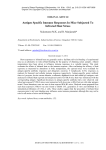
Antigen specific immune responses in mice subjected to infrared heat stress
Статья научная
Short exposures to infrared heat are generally used to facilitate tail-vein bleeding of experimental mice as an alternative to retro-orbital bleeding for the purpose of obtaining serum samples. Altered temperatures have been shown to influence immune responses in a variable manner. This study evaluates the effects of infrared heat on the immune response. After confirming the efficacy of heat exposure as measured by alterations in body temperatures, the exposed mice were evaluated for antigen-specific antibody responses and allogeneic cytotoxic T lymphocytic (CTL) responses as readouts for humoral and cellular immune responses respectively. Antigen-specific serum antibody titers to lysozyme, bovine serum albumin, ovalbumin, diphtheria toxin and rabbit IgG antigens were analyzed in infrared heat exposed and unexposed control C57BL/6 mice that were immunized with the corresponding antigen. Significant decreases in antigen-specific antibody titers were observed only when heat exposed C57BL/6 mice were immunized with lysozyme or BSA but not with other antigens tested. These alterations were not seen in heat exposed BALB/c mice. Dialyzed serum prepared from such heat exposed C57BL/6 was also found to inhibit CTL generation in vitro and inhibited IL-2 stimulated proliferation of CTLL-2 cells. These studies suggest that the procedure of infrared heat exposure prior to tail vein bleeding may influence some immune parameters although this may not be true for all strains of mice and all antigens.
Бесплатно
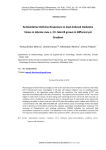
Статья научная
Physiological and biochemical changes as well as the activities of anti-oxidative enzymes under lead (Pb 2+) phytotoxicity were investigated in 20 days old soybean ( Glycine max L.) seedlings grown hydroponically in the laboratory under different pH conditions. The rapid uptake of Pb 2+ was observed immediately after the start of treatment. The quantity of accumulation of Pb 2+ was much higher in roots than in shoots, its level rising with increasing pH from 3.0 to 8.0. Not only that, an oxidative stress conditions were observed due to increased level of superoxide anion radical and hydrogen peroxide in shoots and root cells of 20 days old seedlings when treated with Pb(NO 3) 2 at a concentration of 0, 500, 1000 and 2000 μM. Spectrometric assays of seedlings showed increased level of activities of antioxidant enzymes like catalase, peroxidase and glutathione reductase. The presence of thiobarbituric acid reacting substances (TBARS) indicates the enhanced lipid peroxidation compared to controls. The alteration in the activities of the antioxidant enzymes and the induction of lipid peroxidation reflects the presence of Pb 2+, which may cause oxidative stress.
Бесплатно
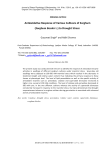
Antioxidative response of various cultivars of sorghum ( Sorghum bicolor L.) to drought stress
Статья научная
The present study was conducted with the aim to identify the response of antioxidant enzyme activities in seedlings of different sorghum cultivars under mannitol stress. Seven-day old seedlings were subjected to 100-500 mM mannitol stress which resulted in the decreases in shoot/root length and relative water content thus indicating the primary response to these tissues at phenotypic level. The level of lipid peroxidation as well as the specific activity of antioxidant enzymes such as peroxidase, catalase and superoxide dismutase increased at higher conc. except at 200 mM conditions. The level of catalase and peroxidase decreased at 500 mM conc. In the two different cultivars whereas the activity of superoxide dismutase consistently increased in response to the mannitol stress. Our data demonstrate that drought responsiveness tolerance in sorghum cultivars during germination is associated with enhanced activity of antioxidant enzymes.
Бесплатно
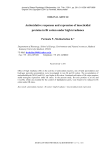
Antioxidative responses and expression of insecticidal proteins in Bt cotton under high irradiance
Статья научная
Effect of high irradiance (HI) on the activity of antioxidant enzymes, rate of lipid peroxidation and hydrogen peroxide accumulation were investigated in non Bt and Bt cotton. The accumulation of malondialdehyde (MDA) and H2O2 was higher in Bt cotton. Sustained cultivation of Bt cotton requires stable transgene expression under HI stress. In the present study, Bt toxin proteins (Cry1Ac and Cry2Ab), which are essential for the control of lepidopteron pests, were found to be reduced in Bt cotton under HI stress.
Бесплатно
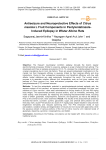
Статья научная
Objective: The frequent neurological condition epilepsy disrupts the brain's regular electrochemical processes. Similar to a seizure, epilepsy is a sign of aberrant brain activity. The developed world has an epilepsy prevalence of 0.5-1%, whereas the underdeveloped world has a larger prevalence due to more risk factors. There are several antiepileptic medications on the market, but their therapeutic efficacy is severely limited by their adverse effects and drug interactions. Owing to their widespread acceptance and beneficial efficiency with few side effects, herbal medicines are used extensively throughout the world. The current study's purpose is to ascertain whether different fruit components, such as fruit juice, residue, and pericarp of Citrus maxima Linn, have anti-seizure properties when used to treat rats with pentylenetetrazole (PTZ)-induced seizures. Methods: To test the antiepileptic potential in pentylenetetrazole-induced epileptic rats, the aqueous extract of fruit pericarp, an aqueous solution of lyophilized powdered fruit juice, and residues of Citrus maxima L were each administered at varying doses of 200 and 400 mg/kg body weight. The experimental animals' physical actions, such as immobility, swimming, and motor activity, were evaluated. By measuring and analysing Neurotransmitter levels, including those of GABA, glutamate, norepinephrine, serotonin, and dopamine, as well as the effects of PTZ on the animal's brain, were examined. Result: The results of the phytochemical screening showed that tannin, coumarin, quinine, glycosides, sugar, and phenols were present. On the thirty-day mark, acute PTZ injection at a dose of 75 mg/kg body weight resulted in seizures that lengthened immobility and reduced swimming time. The PTZ enhanced levels of lipid peroxidation, oxidative stress, and degeneration of neural and non-neural cells (glial cells), while the aqueous extract of various portions of the fruit of Citrus maxima Linn restored levels of glutamate, dopamine, serotonin, norepinephrine, and GABA. Conclusion: According to the findings, convulsions can be treated with Citrus maxima Linn, a traditional source.
Бесплатно
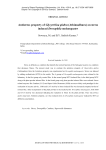
Antistress property of Glycyrrhiza glabra (Athimadhura) on stress induced Drosophila melanogaster
Статья научная
Stress is defined as a condition that disturbs the normal function of the biological system or a condition that decreases fitness. The present study was to evaluate the antistress property of Glycyrrhiza glabra (Athimadura). Here the Antistress property was experimented on Drosophila melanogaster. Stress was induced by adding methotrixate (MTX) to the media. The 4 groups of Drosophila melanogaster were cultured in the laboratory. In the first group only control flies. In the second group MTX induced flies, in the third group MTX along with plant powder induced flies. In the fourth group only plant powder induced flies were cultured. Stress related enzymes like Catalase (CAT) and Super Oxide Dismutase (SOD) are most widely used paradigm for the evaluation of enzyme activity. SOD and CAT Activity in Stress induced flies was increased compared to that of normal flies. After incorporation of the plant powder to the media fed for Drosophila melanogaster, both SOD and CAT Activity was decreased indicating the reduction in Stress by the plant powder. Thus Glycyrrhiza glabra may have Antistress property, as it has reduced stress in Drosophila melanogaster induced by MTX at different concentration.
Бесплатно
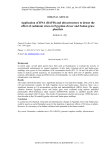
Статья научная
Background In recent years, several plant species have been used as bioindicators to evaluate the toxicity of environmental contaminants on vegetal organisms. In this study, Egyptian clover and Sudan grass seedlings were grown in four cadmium (Cd) concentration levels (0.0, 25, 50 and 100 µM) in MS media to analyze growth responses, Cd accumulation in the shoots and roots of plantlets, proline contents, chlorophylls content and MDA levels of both plantlets. As well as RAPD analysis and leaves ultrastructure were detected. Results The results showed that there was a significant decrease in root and shoot lengths, Chl a, Chl b, total Chl and carotenoids contents for both Egyptian clover and Sudan grass. However, there was a significant increase in Cd accumulation, proline and malondialdehyde (MDA) levels. The genetic variation between Egyptian clover and Sudan grass were evaluated using random amplified polymorphic DNA-polymerase chain reaction (RAPD-PCR) markers to establish specific DNA markers associated with Cd stress. The results of transimssion electron microscopy (TEM) showed a clear disorder in the Cd treated Egyptian clover and Sudan grass seedlings. Conclusion In conclusion, biochemical, molecular and ultrastructure changes in Egyptian clover and Sudan grass could be used as a useful biomarker assay for the detection of genotoxic effects of Cd stress on plants. However, it is necessary to be further confirmed and optimized in the future research.
Бесплатно
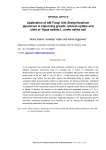
Статья научная
A pot experiment was conducted under polyhouse conditions, to evaluate the effect of two different arbuscular mycorrhizal fungi ( G. mosseae and A. laevis ) in combination with Bradyrhizobium japonicum on growth and nutrition of mungbean plant grown under different salt stress levels (4 dS m −1, 8dS m −1 and 12 dS m −1). It was found that under saline conditions, mycorrhizal fungi protect the host plant against the detrimental effect of salinity. The AM inoculated plants showed positive effects on plant growth, dry biomass production, chlorophyll content, mineral uptake, electrolyte leakage, proline, protein content and yield of mungbean plants in comparison to non-mycorrhizal ones but the extent of response varied with the increasing level of salinity. In general, the reduction in Na uptake along with associated increase in P, N, K, electrolyte leakage and high proline content were also found to be better in inoculated ones. The overall results demonstrate that the co-inoculation of microbes with AM fungi promotes salinity tolerance by enhancing nutrient acquisition especially phosphorus (P), producing plant growth hormones, improving rhizospheric and condition of soil by altering the physiological and biochemical properties of the mungbean plant.
Бесплатно
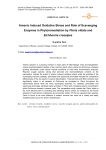
Статья научная
Arsenic pollution is a growing menace in major parts of West Bengal, India and Bangladesh. Arsenic phytoremediation abilities of two common plants Pteris vittata and Eichhornia crassipes growing abundantly under natural tropical conditions of India were biochemically analyzed. Reactive oxygen species, taking total peroxide and malondialdehyde contents as the parameters, indicate the extent of arsenic induced oxidative stress, while the activities of the scavenging enzymes catalase, peroxidase and superoxide dismutase indicate the comparative effectiveness of the two plants in arsenic detoxification. Total peroxide and MDA contents were significantly higher in all samples of Eichhornia as compared to Pteris throughout the experimental period while the three scavenging enzymes viz. catalase, peroxidase and superoxide dismutase exhibited higher activities in Pteris with increasing arsenic concentration while Eichhornia showed a reverse trend. The comparative study reveals that Pteris vittata is the more efficient plant in combating and tolerating arsenic stress, as revealed by the results obtained of biochemical constituents and enzymatic profile. Of the two selected plant species, Pteris is found to be more effective in arsenic removal can serve as a cheap and easily available green source for arsenic detoxification.
Бесплатно
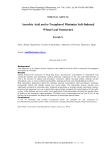
Ascorbic acid and α-tocopherol minimize salt-induced wheat leaf senescence
Статья научная
Background Leaf senescence is an oxidative process, and most of the catabolic events involved in senescence are propagated irreversibly once initiated. Results Salinity hastened the senescence of wheat flag leaves, decreased the concentrations of chlorophyll, total carotenoids, ascorbic acid, total phenol, calcium, potassium, magnesium, K+/Na+ ratio and soluble proteins, as well as the activities of catalase and peroxidase. Conversely, salinity increased sodium, chloride, and the chlorophylla:b ratio, as well as membrane permeability, hydrogen peroxide, and malondialdehyde synthesis. Both antioxidants application reduced the hydrogen peroxide accumulation, lipid peroxidation, membrane permeability, sodium and chloride content over control plants. The antioxidants enzyme activities were significantly increased by antioxidant spray. Enhanced accumulation of ascorbate, phenol, carotenoids, calcium, potassium and magnesium was seen in antioxidants-sprayed plants compared with control plants at 65 days after sowing. Under moderate and sever salinity levels application of both antioxidants alleviated the harmful effects of salinity on leaf senescence related parameter. The higher levels of antioxidants and low level of H2O2 in flag leaf may be the prerequisite for delayed leaf senescence in antioxidants-sprayed plants. Conclusions It can be concluded that ascorbic acid-sprayed plants can postpone the leaf senescence by peroxide/phenolic/ascorbate system which is involved in scavenging the ROS produced during leaf senescence.
Бесплатно
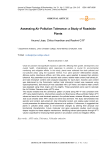
Assessing air pollution tolerance: a study of roadside plants
Статья научная
Urban air pollution has significant impacts on plant life, affecting their growth, development, and overall health. Understanding plant responses to pollution is crucial for environmental monitoring and mitigation efforts. In this study, plants were collected from both polluted and non-polluted areas using the Quadrant method. Four plant species- Alternanthera sessilis , Mimosa pudica , Boerhaavia diffusa , and Sida acuta -were selected to assess their pollution tolerance. Key parameters such as ascorbic acid content, relative water content, leaf extract pH, and total chlorophyll content were analyzed separately for each plant. Ascorbic acid content was determined by the Colorimetric method, total chlorophyll content was measured using Spectrophotometry, leaf extract pH was calculated with a pH meter, and relative water content was assessed using initial, turgid, and dry weights. These parameters were used to calculate the Air Pollution Tolerance Index (APTI) value. The results revealed that the dominance pattern of plants along NH 47 was consistent with APTI value determinations. Alternanthera sessilis and Boerhaavia diffusa exhibited higher APTI values and were the most dominant species in the polluted areas, whereas Mimosa pudica and Sida acuta showed lower APTI values and were less dominant. The study demonstrated that ascorbic acid content, leaf extract pH, total chlorophyll content, and relative water content are crucial parameters for determining plant tolerance to air pollution. Furthermore, it suggested that plants in polluted areas adapt to environmental changes by altering their physical and biochemical characteristics. Future molecular and gene expression studies could provide deeper insights into these adaptive mechanisms. Identifying tolerant plant species through APTI values is significant for employing these species in air pollution control and mitigation efforts.
Бесплатно
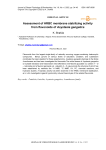
Assessment of HRBC membrane stabilizing activity from flavonoids of asystasia gangetica
Статья научная
Flavonoids from the largest single-family of naturally occurring oxygen-containing heterocyclic compounds. Benzo pyrone of various levels of saturation, oxidation, and substitution constitutes the basic skeleton for these polyphenolics. Asystasia gangetica belongs to the family Acanthaceae and has been investigated for flavonoids The white flowers of Asystasia gangetica on suitable extraction and fractionation have afforded a rare flavone glycoside viz. luteolin 7 - O - rutinoside and a flavonol glycoside viz. patuletin 3 - O- glucuronide the structure of which has been established by methods like 1H NMR, 13C NMR, UV, PC, chemical reactions, and hydrolytic studies. A biphasic activity has been observed in the HRBC membrane stabilization, an in vitro investigation against hypotonicity induced haemolysis of the isolated flavonoids.
Бесплатно
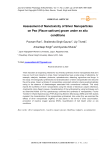
Статья научная
There has been an expanding interest for eco friendly synthesis of silver nanoparticles that don't have so much toxic impacts on crops. Silver nanoparticles have a wide scope of utilizations, for example, catalysis, hardware, photonics, optoelectronics, detecting, agriculture and drugs. In this study, the biologically synthesized and characterization of silver nanoparticles have become the prime areas. Green synthesis of nanoparticles using plant extracts is being explored globally owing to the absence of disadvantages associated with conventional methods. This study reports the synthesis of silver nanoparticles using the extract of Bambusa vulgaris (Bamboo), Azadirachta indica (Neem) leaves, characterization of the synthesized by using techniques such as Ultraviolet-Visible (UV-Vis) spectroscopy confirmed the synthesis of nanoparticles, Fourier Transform Infrared Spectroscopy (FTIR), Scanning Electron Microscopy (SEM) and EDX studies revealed the characteristics of the nanoparticles synthesized. Also under this, we examined the effects of silver nanoparticles (AgNPs) on pea plants in the terms of silver accumulation, production of reactive oxygen species (ROS), Quantification of Cell Death under ex situ conditions.
Бесплатно

